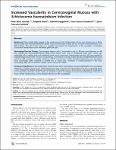Increased vascularity in cervicovaginal mucosa with Schistosoma haematobium infection.
Jourdan, Peter Mark
Roald, Borghild
Poggensee, Gabriele
Gundersen, Svein Gunnar
Kjetland, Eyrun Floerecke
Background: Close to 800 million people in the world are at risk of schistosomiasis, 85 per cent of whom live in Africa. Recent studies have indicated that female genital schistosomiasis might increase the risk of human immunodeficiency virus (HIV) infection. The aim of this study is to quantify and analyse the characteristics of the vasculature surrounding Schistosoma haematobium ova in the female genital mucosa. Methodology/Principal Findings:Cervicovaginal biopsies with S. haematobium ova (n = 20) and control biopsies (n = 69) were stained with immunohistochemical blood vessel markers CD31 and von Willebrand Factor (vWF), which stain endothelial cells in capillary buds and established blood vessels respectively. Haematoxylin and eosin (HE) were applied for histopathological assessment. The tissue surrounding S. haematobium ova had a higher density of established blood vessels stained by vWF compared to healthy controls (p = 0.017). Immunostain to CD31 identified significantly more granulation tissue surrounding viable compared to calcified ova (p = 0.032), and a tendency to neovascularisation in the tissue surrounding viable ova compared to healthy cervical mucosa (p = 0.052). Conclusions/Significance: In this study female genital mucosa with S. haematobium ova was significantly more vascularised compared to healthy cervical tissue. Viable parasite ova were associated with granulation tissue rich in sprouting blood vessels. Although the findings of blood vessel proliferation in this study may be a step to better understand the implications of S. haematobium infection, further studies are needed to explore the biological, clinical and epidemiological features of female genital schistosomiasis and its possible influence on HIV susceptibility.
Dateien zu dieser Publikation
Keine Lizenzangabe

